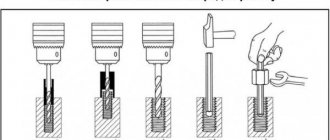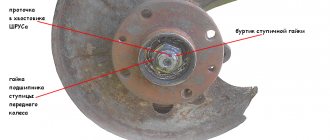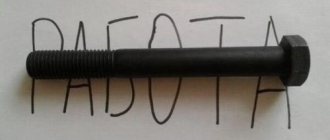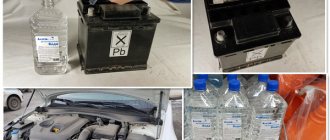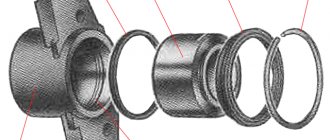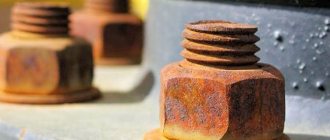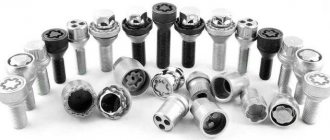- home
- Car muffler
- …
There are really a lot of reasons why a bolt may not unscrew. In one case, this is physical damage (for example, there was a blow), in another case, it is “sticking” from high temperatures (found in hot parts of the car - muffler, manifold, catalyst), and the last is oxidation (such problems occur with parts that come into contact with water - calipers, silent blocks). Yes, and it happens that it is difficult to unscrew the wheel because the “rubber” has not been changed for a very long time, say the car was parked in the winter and there is rust, which stops the removal process. In general, we need to fight this; there are many ways, from special means to rather radical methods. Today we’ll talk about this in detail...
Personally, in my practice, I have encountered almost every one of the listed problems, but the most difficult thing is to unscrew the bolts on the muffler or manifold, because they really get stuck at high temperatures! By the way, something similar can happen with the calipers, because they heat up quite strongly during braking, and then cool down sharply (driving into a puddle). Methods can be divided into chemical and physical.
How to unscrew a hairpin: 25 effective ways and techniques
How to unscrew the pin?
Let's consider several methods, taking into account the condition of the stud and the available tool. How to unscrew a stud by its threaded part
If the stud is long enough and a threaded part for 2 or more nuts is available, then we use one of the following methods:
- screw on the nut, screw the second one all the way into the first one (it is advisable to use tall nuts), then unscrew the stud with a mechanic’s tool (wrench or other);
- use a special tool - a hairpin driver, suitable for the size of a hairpin or a universal one.
An eccentric pin driver is convenient and effective - the greater the force applied to it, the stronger it clamps the pin with the eccentric notch.
How to unscrew a stud if there is only thread available for 1 nut? In this case, at least 4 methods are available:
- cut the nut on one side with a hacksaw (the direction of the cut is along the axis of the threaded part), screw it onto the stud, clamp it with a pipe wrench so tightly that the threaded part, choosing a gap in the cut, tightly grips the stud, direct the force in the direction of unscrewing;
- screw the nut onto the thread, weld it to the stud (for example, with a semi-automatic welding machine) and unscrew it with a wrench (or a head with a knob);
- screw the nut onto the thread, drill a recess in the end of the stud (approximately half the diameter of the stud), drive a TORX socket (E-profile, or another similar one with longitudinal ribs) into this recess and unscrew it by the shank of the socket (you can use your second hand to help with this) with an open-end or socket wrench applying force to the nut in addition to the main force on the torx);
- Using a hacksaw for metal, make a cut at the end for a flat screwdriver, with which you can remove the pin.
In the screwdriver method, a large version or a power version with a T-handle is better suited for this purpose.
How to unscrew a hairpin by its smooth cylindrical part
If only the smooth part of the stud is accessible (for example, the threaded part is broken), then the following techniques are applicable;
- clamp the cylindrical part in a suitable tool (pliers, a pipe wrench, a small vice, a clamp, or the like) and apply force in the direction of unscrewing;
- weld a metal rod to the broken end by welding as a T-shaped handle;
- put on a nut of a slightly larger diameter, weld it to the stud in a circle and unscrew it with a wrench;
- use a square washer as thick as a nut or more, with an internal diameter the same size as the diameter of the cylindrical part of the stud (ideally, if the washer fits on the cylindrical part of the stud with interference), cut it on one side in the same way as the nut in the previous subsection, put it on the stud, clamp pipe wrench and unscrew;
- use a die (the one used for cutting threads), turning the end of the pin to a square of the desired size;
- use a pin driver;
- Using a hacksaw for metal, make a cut at the end for a flat screwdriver, with which you can remove the pin.
In some cases, if possible, to enhance the impact, simultaneously with applying force to a screwdriver or wrench, you can use a second tool (pipe wrench, pliers, etc.), clamping them on the smooth side surface and acting in the direction of unscrewing.
How to unscrew a broken hairpin
If the pin is broken and there is no part protruding above the surface, then you can unscrew it in the following ways:
- using a semi-automatic welding machine, gradually and carefully “build up” a couple of centimeters (if the end of the stud is within the reach of the welding wire) and then unscrew the “build up” using a clamping tool;
- use a special tool - an extractor (looks like a tap, the working part is conical, the thread direction is opposite to the thread of the stud): align the protruding end of the stud with a file (or saw off evenly with a hacksaw), tap exactly in the center, drill a hole of the required diameter along the axis of the stud and depth (approximately 2/3 of the length of the working part of the extractor), insert the extractor and rotate with force until the pin is unscrewed;
- preparation with drilling as in the previous method, only use a tap on the left thread of the stud (if the stud is in the right direction) - when the tap, cutting the thread, rests on the bottom of the drilled recess in the body of the stud, the fragment is often unscrewed;
- drill out the center of the stud, choosing the diameter in such a way as not to touch the threaded part of the socket, and then remove the remaining metal of the stud;
- Drill out the broken part of the stud and the threaded socket on a drilling machine or with a hand drill with a drill of a larger diameter for the repair stud.
Using the method of drilling a recess and driving a Torx tip into it carries the risk of strengthening the wedge in the threaded socket due to the expanding deformation of the stud walls. Taking into account possible complications, we will not recommend it in this situation, despite the fact that it can be used in a limited manner, with certain conditions.
How to unscrew a stuck nut on a wheel
Before starting this difficult work, you need to prepare:
- 6-sided spanner,
- hammer,
- chisel,
- liquid for dissolving rust (WD-40, kerosene, diesel fuel, hydrogen peroxide and others).
You can unscrew the nut only if you damage the joint (sticking) of both parts with rust. The “blurred” rust will allow the cutting to be affected and the nut will turn. Let's look at several ways to unscrew a nut without cutting:
You can unscrew the nut only if you damage the joint (sticking) of both parts with rust
Method 1 - moisten the fasteners with WD-40 or any other preparation that has a high property of fluidity and dissolution of the formed oxide. After waiting 20 minutes for the liquid to “work”, tap with a hammer along the entire perimeter of the nut. Using a hexagon, start unscrewing it back and forth. Method 2 - try tightening the wetted nut first
In this case, the softened layers of rust will crumble, carefully swing the nut in a back-and-forth motion and begin to unscrew. Method 3 - if the nut does not give way, you can try the tapping method, in which the resulting homogeneous layer of rust is destroyed. Using a hammer, apply sharp but gentle blows to the side edges of the nut, being careful not to bend the bolt.
Repeat the process several times. Make sure the fasteners are loose. After the next wetting with the preparation, the nut can be safely unscrewed.
Method 4 - if the previous manipulations did not bring the expected result, you will have to destroy the stubborn knot: the nut can be cut to the ground. To do this, in the direction of unscrewing the nut, apply strong blows with a hammer to a chisel placed at an angle to the side edge of the nut; if the nut is accessible, you can saw it along the axis with a hacksaw or grinder; if sawing is impossible (there is not enough room for access), try drilling out the nut, using a drill, if it is impossible to work with a drill, then use a well-sharpened chisel to cut grooves up to 1 mm deep on the edges of the nut. Gradually go deeper into the body of the nut along the grooves. A deformed nut can be easily unscrewed, but you will have to use a new one during the restoration process.
Method 5 - There is another very unpopular method, since careless handling can damage the paintwork of the car. It is known that metals expand when heated and can “drop” their oxide
This work must be done carefully and quickly, so as not to heat the bolt or the entire connection, but only the nut. For heating, you can use available means - from a match to a blowtorch and boiling water. You can apply this method to the entire threaded connection. To do this, you need to heat the threaded connection several times to +230C and cool it. A change in temperature will contribute to the destruction of oxide in the threads. Lubricate with any penetrating lubricant (kerosene, diesel fuel, etc.). Unscrew the nut.
WD-40 and other penetrating agents
It’s really a very effective thing, I recommend it to everyone. Especially if your bolts or nuts are not subject to temperature stress, and water has entered the threads. This is a very good penetrating substance, just treat the area and wait half an hour. A bolt or nut will yield in 80% of cases.
The disadvantages of this method include the price of the final drug, which is quite high. Although there are now a lot of different analogues, they do not completely repeat the final formula. By the way, you can make a pretty good analogue of WD-40 with your own hands , according to my recipe. Watch a short video, it's useful.
How to unscrew a stuck bolt
Car repairs are often made more difficult due to corrosion and oxidation of fasteners. For example, during assembly at the factory, the master did not treat the threads with lubricants, and during operation water got in there. As a result, the bolt seemed to be stuck tightly, but such a nuisance can be dealt with in several ways.
Unscrew a rusty bolt or nut by tapping
When you tap, rust and scale come off the bolt, making it easier to unscrew. The operation is carried out with a hammer, turning with a special tool to create torque.
Be careful, as you can damage the product and have to drill it out. After removing the fastener, it is cleaned of rust and treated with graphite lubricant
If available, place a boot on the connection.
Using solvents
In the arsenal of any experienced car enthusiast there is always a set of liquids to combat rust and other deposits. They mainly use WD-40 with good penetrating ability into micro-gaps, the cost of which starts from 100 rubles. Along with it, brake fluid, white spirit, kerosene, and Coca-Cola are used. Unlike WD-40, other liquids have a weaker effect, and it is better to pour them into a container and place the stuck compound in it for greater effect.
If the bolt is stuck on the front pillar, the solvent can be carefully poured into the “glass”. The main thing is not to damage the rubber bands on the racks, otherwise you will have to change them.
Moisten a rag with any product, wrap it around the nut and leave it for a while. Then they tap the bolt to destroy the softened rust and begin to unscrew it.
Thermal method
When the solvent does not cope with the task, you can try exposure to fire and cold. Any large auto or hardware store sells a gas torch; it is used to heat the bolt until it turns bright orange. Then they cool it with machine oil and try to weaken it. If the attempt fails, the process is repeated again.
This method does not always help, and if it is close to the paintwork or fuel tank it is very dangerous. When working with a gas burner, you must follow fire safety rules and do not use it if you do not have a fire extinguisher at hand.
Use freezing sprays to preserve the bolt for later use. But such reagents are used mainly by professionals, since in domestic conditions this is a costly and unprofitable matter.
Acids
This is also an effective method, however, it is not as safe. For example, if a bolt or nut is located next to rubber products, it is better not to use it, because the acid can destroy soft materials.
Usually high concentrations of sulfuric acid are used; if the bolt is simply oxidized and not stuck, then just drop it on the thread - the oxides will come off and after a few hours everything will unscrew perfectly. If you need to unscrew a “difficult case,” then a plasticine rim is made around the cap and a few drops of acid are added there, to enhance the effect, a piece of zinc is also placed (a galvanic couple is created). After 12 - 24 hours, almost any bolt, even a stuck one, can be unscrewed. However, it is not always possible to make such a side from plasticine.
Prevention
Judging by the information given above, unscrewing a rusted bolt or nut is not difficult, but it takes a lot of time and effort.
It’s easier to prevent problems and take into account a number of recommendations. Below are just a few of them:
Coat the nuts that hold the muffler with an anti-corrosion compound before tightening. After this, treat the product with grease (for greater effectiveness, add a little graphite to the composition). This prevents sticking. Wash the engine and the car as a whole from time to time. Dust and dirt that accumulate on the surface accelerate the process of corrosion. Buy only high-quality fasteners made of durable metal
When choosing, pay attention to such a criterion as strength class. Try not to skimp on nuts and bolts, because using cheap products leads to a number of problems in the future
At the same time, the question of how to unscrew a rusty fastener can become very relevant. Remember that we are talking about reliability and durability, savings on which are inappropriate. Do not abandon your car in a nearby or open parking lot. Storing a vehicle in a closed garage is an opportunity to reduce the risk of corrosion on connections. The negative impact of rain or cold negatively affects the condition of the body, as well as the vehicle’s fastenings. When performing work, use only high-quality tools - gas or ring wrenches, as well as special heads. Of course, this will require more money to purchase, but it is more convenient to use such a tool, and the mounts themselves last longer. A good tool allows you to solve two problems - maintain the integrity of the nut and protect it from damage, and also stretch the fastener with the required torque.
Heat
Heating is very effective in such difficult areas as, say, a manifold, muffler or catalyst . The bolts really stick there due to high temperatures. You won't be able to unscrew them with WD-40, and it's difficult to use acid under the car. Therefore, here you need to act using the “wedge-wedge” method. That is, if it’s stuck due to heating, then you need to unscrew it through it.
If the mount is small, then it can be heated with a regular soldering iron and held for about 10 - 15 minutes. However, if the case is severe, this will not help. An open flame burner works great here - special cans are sold. The bolt heats up almost to a red color, the metal expands (the “sticking” effect is weakened), now it needs to be cooled sharply (preferably with a penetrating compound like WD-40), it turns out like a mini blow, you can safely unscrew it.
Electric heating
An open fire is of course good, but again there is a chance of burning something! Therefore, it is better to use electric heating; here we are not talking about a “soldering iron”; rather, this is the principle of a welding machine, but with low voltage.
We take a transformer from a microwave, wind a thick copper cable onto the secondary winding - this gives us a voltage of 1.5 Volts, but the current is simply off scale. Two probes, preferably made of thick sheets of copper, are attached to the ends of this wire and sharpened. These two feeler gauges need to be installed at the beginning and end of the bolt (or nut and bolt). Thus, a strong heating will occur, then everything is as with an open source of fire, cool with a penetrating agent and unscrew it. Let's watch a useful video of this method.
Removal and installation of the exhaust pipe UAZ 31519
You will need: keys “12”, “13”, socket head “17”.
1. Place the vehicle on a viewing ditch or lift.
2. Disconnect the oxygen concentration sensor wiring harness connector.
3. Unscrew the four pairs of nuts securing the exhaust pipe to the exhaust manifold.
4. Unscrew the three nuts securing the catalytic converter to the exhaust pipe, remove the bolts...
5. ...and remove the sealing gasket installed between the converter and the exhaust pipe.
6. Unscrew the nut securing the clamping bar, holding the bolt from turning with a second wrench...
7. ...remove the pressure plate...
8. ...and remove the inlet pipe.
9. Unscrew the oxygen concentration sensor from the exhaust pipe.
10. Remove the old exhaust pipe gasket.
11. Install the new exhaust pipe in the reverse order of removal.
Video about “Removing and installing the exhaust pipe” for UAZ 31519
UAZ loaf: removing the manifold and preparing to remove the cylinder head Replacing the UAZ muffler corrugation - Repairing the steering column (steering gearbox)
Source
Physical methods
Actually, there are only two of them, but be careful, you can break the edges and make it even worse, so:
- Tapping - we take an ordinary hammer and simply tap the nut or bolt (not too hard, so as not to dent it), often this is enough, oxides, rust or even “sticking” comes off and the connection can give way. If this does not happen, try to concentrate the blow, take an “impact screwdriver” and direct the force on the nut or bolt head. THERE IS NO NEED TO HIT THE THREAD, IF YOU BRING IT, IT WILL BE EVEN WORSE, then just cut it off.
- Lever or shoulder. Often it is not possible to unscrew it with a key; there is simply not enough lever force. It is enough to lengthen the handle, take a longer “knob” or put a metal pipe on the key, the connection can unscrew. However, be careful, the edges can be torn off!
What is strictly forbidden to do (use of force)?
The main mistake of many beginners is a thoughtless approach to twisting and the use of “force” methods.
Remember, in order to unscrew a stuck element, it is important to be patient and not rush. Solving the problem requires a consistent and measured approach
Haste in resolving an issue can cause many problems.
Thus, car owners often rush to unscrew a rusty bolt and tear off its upper part.
The result is drilling out the broken product, which will take a lot more time.
In addition, the result of haste may be damage to nearby nodes with the key, which will lead to the need for additional investments.
Before starting work, draw up an action plan, and then begin to implement it.
If you work in a hurry, the total cost of time and money may be higher. Moreover, there are enough methods to quickly unscrew a rusted nut or bolt. We will talk about them below.
Grinder or cut
Perhaps the very last thing, if all else fails, and even if the edges are torn off, then the only thing to do is “cut”! This is usually done with a grinder; you can use a hacksaw if you can’t get to it with a grinder (or it’s dangerous). There’s really nothing to comment on here, we cut it off, remove the remains, and install a new bolt (nut).
I’ll finish here, I would like to note that in 80% of cases WD-40 (or the analogue that I showed you) helps. In other cases (catalyst, manifold, catalytic converter), heating helps. Tested – 100%!
Read our AUTOBLOG, subscribe to updates, it will be interesting.
(
8 votes, average: 4.75 out of 5)
Similar news
Removing the catalyst. Pros and cons, consumption, firmware - revealed.
Water in the muffler. Reasons, how to get rid of it and whether it can be drilled
Catalyst service life. When should it be changed?
Add a comment Cancel reply
Replacing the exhaust pipe
We carry out the work on an inspection ditch or a lift.
Remove the resonator and muffler (see Replacing the resonator and Replacing the muffler).
Using a 17" socket with an extension, unscrew the brass nuts of the two studs securing the exhaust pipe to the exhaust manifold.
Using a 13mm wrench, unscrew the two stepladder nuts securing the exhaust pipe to the transfer case bracket.
Remove the exhaust pipe from the exhaust manifold studs.
A sealing gasket is installed between the exhaust pipe and the manifold.
We remove the flange from the intake pipe and replace it with the new pipe.
We install the exhaust pipe in the reverse order, replacing its gasket, brass nuts with new ones and applying graphite lubricant to the threaded connections.
USEFUL TIPS
Muffler patch
If the muffler is burnt out, and there is no time for serious repairs, take a piece of fiberglass and dip it in liquid glass (silicate glue). Apply the patch to the burnt area and additionally wrap the connection with wire. Such repairs will be enough for several hundred kilometers.
Source
